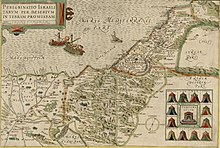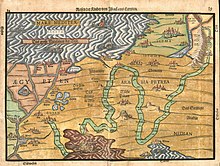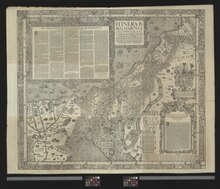| Revision as of 22:53, 26 December 2019 editOnceinawhile (talk | contribs)Autopatrolled, Extended confirmed users, Pending changes reviewers49,717 edits +map← Previous edit | Revision as of 15:07, 9 March 2020 edit undoZhomron (talk | contribs)Extended confirmed users5,621 editsNo edit summaryNext edit → | ||
| Line 13: | Line 13: | ||
| Biblical commentators like St ] in his , ] (''Letter to Acca: "De Mansionibus Filiorum Israhel"'') and St ] discussed the Stations according to the ] meanings of their names.<ref>Gregory F. LaNave, ''et al.'', ''The Fathers of the Church: Mediaeval Continuation, , Letter 160, pp. 110 ff., The Catholic University of America Press, Washington D.C. (2005)</ref> ] modeled the 42 chapters of his '']'' on them.<ref>Julia Bolton Holloway, ''Sweet New Style: Brunetto Latino, Dante Alighieri and Geoffrey Chaucer'', , (2003)</ref> | Biblical commentators like St ] in his , ] (''Letter to Acca: "De Mansionibus Filiorum Israhel"'') and St ] discussed the Stations according to the ] meanings of their names.<ref>Gregory F. LaNave, ''et al.'', ''The Fathers of the Church: Mediaeval Continuation, , Letter 160, pp. 110 ff., The Catholic University of America Press, Washington D.C. (2005)</ref> ] modeled the 42 chapters of his '']'' on them.<ref>Julia Bolton Holloway, ''Sweet New Style: Brunetto Latino, Dante Alighieri and Geoffrey Chaucer'', , (2003)</ref> | ||
| ==Locating the Stations== | |||
| Attempting to locate many of the stations of the Israelite Exodus is a difficult task, if not totally infeasible. Though scholars have conceded that it is at the very least plausible for the narrative of the Exodus to have some sort of historical basis,{{sfn|Redmount|2001|p=87}}{{sfn|Faust|2015|p=476}}{{sfn|Sparks|2010|p=73}} the event in question would be nowhere near the mass-emigration and subsequent forty years of desert nomadism described in the ]. <ref name="Dever2001">{{cite book|author=William G. Dever|title=What Did the Biblical Writers Know and When Did They Know It?: What Archeology Can Tell Us About the Reality of Ancient Israel|url=https://books.google.com/books?id=6-VxwC5rQtwC&pg=PA99|year=2001|publisher=Wm. B. Eerdmans Publishing|isbn=978-0-8028-2126-3|page=99}}</ref><ref>{{cite book|author=Avraham Faust|title=Israel's Exodus in Transdisciplinary Perspective: Text, Archaeology, Culture, and Geoscience|url=https://www.academia.edu/11906343|year=2015|publisher=Springer|isbn=978-3-319-04768-3|page=476}}</ref> Even if the Exodus ''had'' occurred to the scale and sequence the modern Hebrew Bible ascribes to it, there are a plethora issues in trying to examine the progression of the event outside the lack of material evidence. Descriptions of many of the stations lack recognizable distinguishing features or are very broadly defined. Examples include ], the fifth station, which is succinctly defined as a place where the Israelites found the drinking water to be exceptionally bitter, or the "]" which is simply described as the area between ] and ]. Many of the qualifiers used to ascertain the location are inconsistent or can't be reliably placed, one such example being the aforementioned Wilderness of Sin, an area whose location cannot be positively determined thanks to numerous traditions of the exact location of Mount Sinai. Other than that, geographical changes need to be taken into consideration. Features of desert environs such as Sinai are subjected to a number of weathering processes that can drastically alter local conditions in a matter of days, let alone the implicit 3,000 years since the Exodus and modern studies and surveys. Springs can dry up, ]s can radically change course, geological formations could erode or be swept away by the sands, etc. Additionally, if an Exodus truly occurred historically in some analogous or similar manner to that which is described in the Bible, the material culture of a group of newly freed slaves wandering in a vast desert would be admittedly scant and likely would not have survived nearly as long as, say, a sedentary village community or even city in a desert region. As such, identifying the stations of the Exodus are almost entirely conjectural. | |||
| ==List of the Stations of the Exodus== | ==List of the Stations of the Exodus== | ||
Revision as of 15:07, 9 March 2020



The Stations of the Exodus are the 42 locations visited by the Israelites following their exodus from Egypt, recorded in Numbers 33, with variations also recorded in the books of Exodus and Deuteronomy.
According to the documentary hypothesis, the list of the Stations is believed to have originally been a distinct and separate source text. In this hypothesis, it is believed that the redactor, in combining the Torah's sources, used parts of the Stations list to fill out awkward joins between the main sources. The list records the locations visited by the Israelites, during their journey through the wilderness, after having left Egypt. Consequently, the parts which were inserted to join up the sources appear in suitable locations in the books of Exodus and Numbers.
However, a slightly variant version of the list appears in full at Numbers 33, and several parts of the journey described in the full list, most noticeably the journey from Sinai to Zin, do not appear in the fragmented version.
Both versions of the list contain several brief narrative fragments. For example " ... and they came to Elim, where there were twelve wells of water, and seventy date-palms...". It is a matter of some debate as to how much of the narrative is part of the original text of the list, and how much is extra detail added into it by the redactor.
The situation also occurs in reverse, where some brief texts, within parts of the list, and ascribed to the redactor, are usually regarded as not being part of the list of stations, albeit without much conviction. This is particularly true for Numbers 21:14–15, which references unknown events in the lost Book of the Wars of the Lord, and Numbers 21:16b–18a, describing the digging of the well at Beer.
Biblical commentators like St Jerome in his Epistle to Fabiola, Bede (Letter to Acca: "De Mansionibus Filiorum Israhel") and St Peter Damian discussed the Stations according to the Hebrew meanings of their names. Dante modeled the 42 chapters of his Vita Nuova on them.
Locating the Stations
Attempting to locate many of the stations of the Israelite Exodus is a difficult task, if not totally infeasible. Though scholars have conceded that it is at the very least plausible for the narrative of the Exodus to have some sort of historical basis, the event in question would be nowhere near the mass-emigration and subsequent forty years of desert nomadism described in the Tanakh. Even if the Exodus had occurred to the scale and sequence the modern Hebrew Bible ascribes to it, there are a plethora issues in trying to examine the progression of the event outside the lack of material evidence. Descriptions of many of the stations lack recognizable distinguishing features or are very broadly defined. Examples include Marah, the fifth station, which is succinctly defined as a place where the Israelites found the drinking water to be exceptionally bitter, or the "Wilderness of Sin" which is simply described as the area between Elim and Mount Sinai. Many of the qualifiers used to ascertain the location are inconsistent or can't be reliably placed, one such example being the aforementioned Wilderness of Sin, an area whose location cannot be positively determined thanks to numerous traditions of the exact location of Mount Sinai. Other than that, geographical changes need to be taken into consideration. Features of desert environs such as Sinai are subjected to a number of weathering processes that can drastically alter local conditions in a matter of days, let alone the implicit 3,000 years since the Exodus and modern studies and surveys. Springs can dry up, wadis can radically change course, geological formations could erode or be swept away by the sands, etc. Additionally, if an Exodus truly occurred historically in some analogous or similar manner to that which is described in the Bible, the material culture of a group of newly freed slaves wandering in a vast desert would be admittedly scant and likely would not have survived nearly as long as, say, a sedentary village community or even city in a desert region. As such, identifying the stations of the Exodus are almost entirely conjectural.
List of the Stations of the Exodus
| Station | Biblical reference | Description | Modern location |
| Raamses | Ex. 12:37; Nu. 33:3,5 | The Raamses district was of the highest quality land in Egypt (Ge. 47:11) | uncertain although it has been argued that it was Pi-Ramesses |
| Sukkoth | Ex. 12:37, 13:20; Nu. 33:5-6 | An Egyptian city near the border | Tjeku (Zuko), Tell el-Maskhuta (Pithom) |
| Etham | Ex. 13:20; Nu. 33:6-8 | "On the edge of the wilderness" | Ismailia? |
| Pi-Hahiroth | Ex. 14:2-3; Nu. 33:7-8 | Lit. Mouth of the Gorges, "between Migdol and the sea, opposite Ba'al-Zephon" (possibly "the Bay of Hiroth") | Prob. a channel opening into one of the Bitter Lakes or the Mediterranean- Pi-hahiroth was located near the Red Sea. |
| Marah | Ex. 15:23; Nu. 33:8-9 | Lit. 'bitterness' | 30 kilometres north of As Suways (the port of Suez)? |
| Elim | Ex. 15:27, 16:1; Nu. 33:9-10 | Had 12 wells and 70 palm trees | ? |
| By the Red Sea | Nu. 33:10-11 | - - | Near Gulf of Suez |
| Sin Wilderness | Ex. 16:1, 17:1; Nu. 33:11-12 | God supplies quail and manna, "Between Elim and Sinai" | |
| Dophkah | Nu. 33:12-13 | - - | - - |
| Alush | Nu. 33:13-14 | - - | - - |
| Rephidim | Ex. 17:1, 19:2; Nu. 33:14-15 | God commands Moses to strike a "Rock of Horeb", water gushes forth to alleviate thirst. | ? |
| Sinai Wilderness | Ex. 19:1-2; Nu. 10:12, 33:15-16 | Near Mount Sinai | |
| Kibroth-Hattaavah | Nu. 11:35, 33:16-17 | Lit. Graves of Longing or Graves of Lust | - - |
| Hazeroth | Nu. 11:35, 12:16, 33:17-18 | - - | - - |
| Rithmah | Nu. 33:18-19 | - - | - - |
| Rimmon-Perez | Nu. 33:19-20 | - - | - - |
| Libnah | Nu. 33:20-21 | - - | - - |
| Rissah | Nu. 33:21-22 | - - | - - |
| Kehelathah | Nu. 33:22-23 | - - | - - |
| Mount Shapher | Nu. 33:23-24 | - - | - - |
| Haradah | Nu. 33:24-25 | - - | - - |
| Makheloth | Nu. 33:25-26 | - - | - - |
| Tahath | Nu. 33:26-27 | - - | - - |
| Tarah | Nu. 33:27-28 | - - | - - |
| Mithcah | Nu. 33:28-29 | - - | - - |
| Hashmonah | Nu. 33:29-30 | - - | - - |
| Moseroth | Nu. 33:30-31 | - - | - - |
| Bene-Jaakan | Nu. 33:31-32 | - - | - - |
| Hor Haggidgad | Nu. 33:32-33 | - - | - - |
| Jotbathah | Nu. 33:33-34 | - - | - - |
| Abronah | Nu. 33:34-35 | - - | - - |
| Ezion-Geber | Nu. 33:35-36 | - - | Near northern tip of Gulf of Aqaba |
| Kadesh | Nu. 20:1,22, 33:36-37 | Located in the Wilderness of Zin; Miriam's burial place | Probably Ain el Qadeis |
| Mount Hor | Nu. 20:22, 21:4, 33:37-41 | On the Edomite border; Aaron's burial place | - - |
| Zalmonah | Nu. 33:41-42 | - - | - - |
| Punon | Nu. 33:42-43 | - - | - - |
| Oboth | Nu. 21:10-11, 33:43-44 | - - | - - |
| Abarim Ruins | Nu. 21:11, 33:44-45 | - - | - - |
| Dibon Gad | Nu. 33:45-46 | - - | - - |
| Almon Diblathaim | Nu. 33:46-47 | - - | - - |
| Abarim Mountains | Nu. 33:47-48 | Israelites encamped beneath Mount Nebo | - - |
| Moab Plains | Nu. 22:1, 33:48-50 | Israelites encamped on the Jordan River from Beith Hayishimoth to Aveil Hashittim | Occupied most of the Trans-Jordan region |
References
- Nili S. Fox, in Adele Berlin, Marc Zvi Brettler (editors), The Jewish study Bible, Jewish Publication Society TANAKH Translation, Oxford University Press, Oxford (1999), p. 349: "The literary style of the itinerary, the repetition of campsite names, and the highlighting of events in those places closely resemble extant military records from the ancient Near East, especially from Assyria. Accordingly, the notation in this Priestly source that Moses recorded the starting points of their various marches (v. 2) fits the genre. Some scholars, however, consider ch 33 a composite text extracted from other portions of Numbers, Exodus, and Deuteronomy."
- Gregory F. LaNave, et al., The Fathers of the Church: Mediaeval Continuation, The Letters of Peter Damian 151-180, Letter 160, pp. 110 ff., The Catholic University of America Press, Washington D.C. (2005)
- Julia Bolton Holloway, Sweet New Style: Brunetto Latino, Dante Alighieri and Geoffrey Chaucer, Chapter III, (2003)
- Redmount 2001, p. 87. sfn error: no target: CITEREFRedmount2001 (help)
- Faust 2015, p. 476. sfn error: no target: CITEREFFaust2015 (help)
- Sparks 2010, p. 73. sfn error: no target: CITEREFSparks2010 (help)
- William G. Dever (2001). What Did the Biblical Writers Know and When Did They Know It?: What Archeology Can Tell Us About the Reality of Ancient Israel. Wm. B. Eerdmans Publishing. p. 99. ISBN 978-0-8028-2126-3.
- Avraham Faust (2015). Israel's Exodus in Transdisciplinary Perspective: Text, Archaeology, Culture, and Geoscience. Springer. p. 476. ISBN 978-3-319-04768-3.